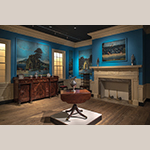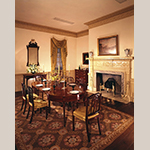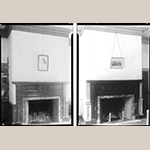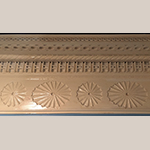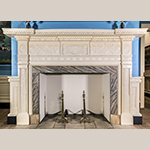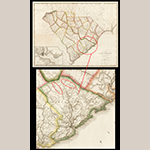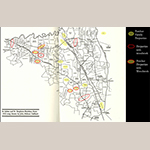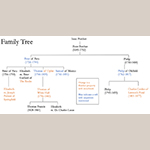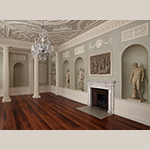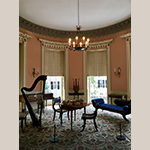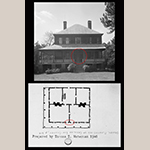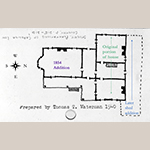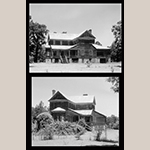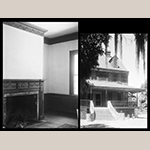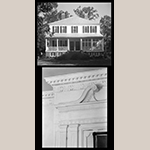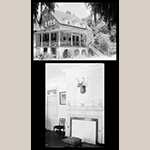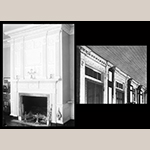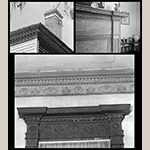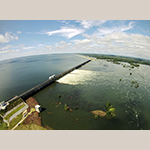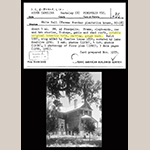The interior woodwork from White Hall Plantation reflects the legacy of the highly skilled African American carvers and carpenters who were enslaved by families of Huguenot descent in Berkeley County, South Carolina (Figure 1). While the house at White Hall Plantation does not survive, a room was saved and is exhibited at the Museum of Early Southern Decorative Arts. Though the room had been interpreted as a dining room in the past (Figure 2), when compared to historical photos it is clear that it is actually White Hall’s former drawing room (Figure 3). Despite the obvious skill and talent of the craftsmen who completed the architectural interiors, until recently the museum knew little about the specific carpenters and carvers who created the room’s intricate carved and gouged woodwork.
White Hall was built for Thomas Porcher (1796–1843) and his wife Catherine Gaillard Porcher. While researching a group of quilts with Porcher and Palmer family histories, MESDA’s Adjunct Curator of Textiles Jenny Garwood discovered a reference to interior woodwork at a family house called Lawson’s Pond that was attributed to an enslaved craftsman called “Black Washington.”[1] While other early twentieth-century authors such as Mills Lane and Samuel Gaillard Stoney commented on Lawon’s Pond’s magnificent woodwork, they lamented their inability to identify the craftsmen responsible. Neither suggested the possibility that it was the work of an enslaved craftsman.
Harriette Kershaw Leiding published Historic Houses of South Carolina in 1921. The book moves region by region through the state, identifying properties of note for their architectural significance or notable inhabitants. In the section on St. John’s and St. Stephen’s Parishes, she describes the house of Philip Porcher, likely referring to Lawson’s Pond, although the construction date is questionable, stating the house:
which still stands, was built in 1812 by slave labor, and is of black cypress, the timber having been cut on the place. … It is called a double-story house, and stands on a nine-foot brick foundation the pillars of which are about six by three feet. The bricks were had from a brick kiln on the plantation; the hole where the clay was dug can still be seen on the edge of the woods. The interior decorations were done by a slave called Black Washington.[2]
Thus far no enslaved carpenters named Washington have been discovered in Porcher family wills or probate inventories; however, other enslaved carpenters have been identified by name, and it seems likely that a network of enslaved carpenters worked in St. John’s and St. Stephen’s Parishes on the Porcher family houses as well as those of their relatives. Thus a search began for the names of enslaved carpenters who built and carved the woodwork at White Hall and other Berkeley County plantations built for members of the extended Porcher family.
These individuals were remarkable craftsmen. While Thomas T. Waterman, in his 1939 HABS survey, wrote that the White Hall room now at MESDA “lacks logic and direction” compared to the house’s other first-floor room, the details are still quite pleasing. The chair rail, or dado cap, has a bulbous fascia that is carved with tiny sunbursts, alternating with horizontal blocks of fluting (Figure 4). The cornice around the room has alternating circular and elliptical sunbursts, above which is a band of basket-weave pattern topped with a rope pattern to form the corona (Figure 5). The cymatium is carved with a small stylized guilloche, while its soffit has a larger guilloche pattern.
The mantel above the fireplace features elliptical sunbursts, half-elliptical sunbursts, and quarter sunbursts in the corners of the center frieze panel (Figure 6). The entire frieze is surrounded by a row of guilloche, below which are small circular sunbursts alternating with reeding. The pilasters supporting the mantel on each side are reeds with gouging, alternating with rope, capped by the small sunburst and vertical blocks of fluting, and then one elliptical sunburst on each side of the mantel. The rope molding reappears, but this time features gouged circles, imitating the guilloche below it. The fireplace facing is of Pennsylvania blue marble, which Waterman noted is typical in the fine houses of this region of Berkeley County.[3]
— ♦♦◊♦♦ —
St. John’s Parish in Berkeley County, South Carolina was incorporated by the Church Act of 1706.[4] St. Stephen’s is the bordering parish to the northeast. St. John’s Parish is approximately fifty miles from Charleston, following the Cooper River to the northwest to the Santee River (Figure 7). The majority of the residents in St. John’s Parish were French Huguenots, who began immigrating to South Carolina, usually through England, after the Edict of Nantes was revoked in 1685. Discussion among the British colonists of naturalizing French Huguenots in South Carolina began in 1696, but the act to allow naturalization was not passed until March 1697.[5] In areas like Berkeley County, kinship networks among the French Huguenot families remained important, even after the French language and the French church were abandoned.
The cultivation of indigo and rice using enslaved labor initially brought wealth to this area. By the early nineteenth century these crops had been replaced by Santee long-staple cotton, a hybrid between upland cotton and Sea Island cotton. While the Santee cotton could not match Sea Island cotton in terms of quality, it was produced in great quantities.[6] In addition to establishing large plantations, many French Huguenots helped establish small pineland villages as summer retreats. The village of Pineville was settled in 1794 as a summer and fall retreat for the health of the families who lived on plantations along the water, who sought refuge from the heat and fevers of the summer months (Figure 8).[7] The French Huguenots of Berkeley County remained connected by staying in the same geographic region and often intermarrying.
As early as the mid eighteenth century, merchants and planters wanted to connect the middle of South Carolina to the port of Charleston by water. Rivers and creeks were already the preferred method of transportation in the colonies, as travel by land was difficult and treacherous due to poor quality roads.[8] In 1770 the Commons House of Assembly discussed the possibility of a canal connecting the Cooper and Santee rivers. Finished goods and foodstuffs could then travel inland from Charleston to these mid-state settlements and plantations. The American Revolution delayed the project. In January 1782, the Commons House of Assembly met in Jacksonborough, South Carolina, where they approved a commission to determine the place for the canal to connect the two rivers. Four years later, the Assembly chartered a company to build the canal. The company hired Swedish engineer, Colonel John Christian Senf, who surveyed the area to find his own route for the canal, ignoring Henry Mouzon’s previously surveyed options that followed the natural water routes.[9]
In the post-Revolutionary War period, South Carolina planters who were transitioning from indigo to cotton production were unwilling to make those they enslaved available for the canal project. At the same time, most white laborers were not interested in working in the swamps in the summer due to the heat and risk of fevers. Therefore, a labor shortage delayed construction on the canal until 1793. The work was hard. Canal builders used picks, shovels, and wheelbarrows to create the Santee Canal. With the help of 1,000 laborers, the canal was finally completed in 1800 at a cost of $750,000. Unfortunately, the canal did not last long, as periodic droughts made sections impassable, and the railroad soon provided a faster, more dependable alternative.[10] By the 1840s the canal was rarely used.[11] While its impact was limited, the Porcher families, many of them cotton planters, benefitted from this canal in its early days to get their products to the port at Charleston.
— ♦♦◊♦♦ —
The story of the Porcher family in Berkeley County, South Carolina begins with Isaac Porcher in the seventeenth century (Figure 9). Isaac Porcher, born in St. Severe in Berry, France, the son of Isaac Porcher and Suzanne Ferre, married Claude Cherigny. Sometime after the Edict of Nantes was revoked they fled to England, and then on to South Carolina. Their children were Isaac, Pierre, Madelaine, and Claude, born in both England and South Carolina.[12] Leiding asserts that Isaac Porcher was in the Charleston area by 1687, settling first near Goose Creek, in lower Berkeley County.[13]
Isaac was the first of the Porcher line to come to the colonies and the Porchers associated with White Hall and the family’s other Berkeley County plantations are his direct descendants. Isaac had a son named Peter (1695–1752), who had two sons of note for this project, Philip (1730–1800) and Peter (1726–1781). The son named Peter (1726–1781), had multiple children, Peter (1756–1793) of Peru Plantation, Elizabeth (married to Peter Gaillard of the Rocks), Thomas (1766–1835) of Ophir Plantation, and Samuel (1761–1851) of Mexico Plantation. His child Thomas (1766–1835) of Ophir Plantation, gave the house and land at White Hall Plantation, likely as a wedding gift, to his own son Thomas (1796–1843) and wife Catherine Gaillard Porcher.
On the other side of the family, Peter’s son, Philip (1730–1800) of Cedar Spring Plantation had a son named Philip (1762–1817) of Oldfield Plantation who had two sons, Philip (1793–1833) of Tibbekudlaw and Charles Cordes (1801–1877) of Lawson’s Pond. The house named Lawson’s Pond survives and has very similar woodwork to White Hall. While the Porcher family genealogy is quite complex, especially with first cousins marrying each other, it does establish a strong network of kinship as they almost all remained in Berkeley County, passing land onto their children and growing the size of the extended family. Many of these plantation houses share the same style of intricate woodwork, suggesting that it was completed by the same group of enslaved carpenters and carvers.
— ♦♦◊♦♦ —
The enslaved carpenters of Berkeley County carved in an exuberant, although vernacular, form of Adamesque Neoclassicism, which was at the height of fashion from 1780 to 1830 in Charleston. The ancient world was rediscovered in the eighteenth century with excavations at Herculaneum in 1735 and Pompeii in 1755. These archaeological discoveries became models for classical architecture beginning in England and Scotland, then spreading to the colonies. Brothers James, William, and Robert Adam, for whom the style is named, studied in Italy and then opened an architectural firm in London, where they specialized in architectural interiors. Elaborate details, especially in moldings, were common. Neoclassical style was light and airy, thin and graceful. The urns, garlands, medallions, and other details were enhanced by light, pastel paint colors (Figure 10). The Adam style reached its height in England in the 1770s, but the American Revolution delayed its transference to America, where it did not begin to appear in buildings and furnishings until the 1790s.[14]
As the Adamesque style crossed the Atlantic, it was simplified and its proportions became even thinner. Circular decorations and room shapes were preferred. Surface details on doors, window frames, and mantels were completed in carved wood or cast plaster, often in garlands, sunbursts, or geometric designs. Instead of wood paneling covering the walls, as in the Georgian era, elaborate printed wallpaper or simple painted plaster was used between the chair rail and cornice (Figure 11).[15] In the rural areas surrounding Charleston, Adamesque decoration took on an exuberance not seen in the city, with fanciful carved details. Local craftsmen created architectural details from wood rather than casting them from plaster. Most of these houses were built in the early nineteenth century by newly rich cotton planters, many of whom were part of the region’s extensive Huguenot kinship network.
In addition to sharing similar carved interior woodwork, the majority of these houses also had similar floor plans (Figure 12). Most of these houses were two stories with a hipped roof, frame exterior, on a raised brick basement. The houses did not have a center hall, but instead had two front doors leading into two large front chambers. Behind the two chambers was a rear stair hall, flanked by two smaller rooms. The carved woodwork appears most often on mantels, sometimes entire chimney breasts, and also above doors.[16] In communities that are relatively isolated and cohesive, like the French Huguenots and their descendants in Berkeley County, those with wealth and a taste for refinement would often imitate one another, using a shared set of craftsmen working in a local vernacular.[17] They likely shared the labor of enslaved carpenters and other tradespeople, sometimes under the direction of white carpenters working in the role of general contractors, to create the elaborate gouged woodwork so common among these early-nineteenth-century Berkeley County, South Carolina plantation houses.
The land where White Hall Plantation once stood was the site of a colonial-era tavern and inn on the Congaree Road, five miles northwest of the village of Pinopolis. The name comes from an early owner, Blake Leay White (1770s era). Thomas Porcher (1766–1835) of Ophir built the house for his son Thomas (1796–1843) and wife Catherine Gaillard Porcher (daughter of Captain Peter Gaillard of The Rocks). While White Hall was constructed sometime between 1818 and 1824, Thomas and Catherine married in 1822, so it is very likely that the house was completed by then.[18]
Unlike most of its Berkeley County neighbors, White Hall is a two-story gable roofed, center-hall plan house (Figure 13). Its plan is not unlike that of the Charleston single house, except that it originally had twin front doors like many of the other houses in St. John’s Parish. Since it did have a center hall, however, one door entered the hall, while the other entered the front chamber. The nine-over-nine windows had paneled shutters on the front of the house, while the sides were louvered. The exterior details were maintained when an 1850s addition with a bow-front window was added (Figure 14).[19] It is fortunate that the drawing room woodwork from White Hall is preserved today at MESDA, as there are several other St. John’s Parish plantations that only survive in photographs and the written record. Although exact construction dates are sometimes difficult to determine, several plantations seem to predate White Hall, including Thomas’s father’s house, Ophir (1810), Thomas’s father-in-law Peter Gaillard’s house The Rocks (1805), William Sinkler’s Eutaw (1808), and likely Joseph Palmer’s Springfield (1818) (Figures 15-18).
— ♦♦◊♦♦ —
Wills and probate inventories help to identify the enslaved artisans who were responsible for the woodwork at White Hall and other plantations in the region. These documents identify the enslaved men who were known for their skills as carpenters. Several generations of the Porcher family enslaved skilled African American carpenters and often left instructions in their wills for what work these carpenters should be employed on and to whom they would be given. For example, the 1781 will of Peter Porcher (1726–1781) identifies three enslaved carpenters: Sharloe, Jemmy, and Jupiter. Peter ensured that each of his three sons had their own plantation, with Peter (1756–1793) at Peru, Samuel (1761–1851) at Mexico, and Thomas (1766–1835) at Ophir. In his will their father directs:
That my Three Negro Carpenters called Sharloe, Jemmy & Jupiter shall be kept & employed at Work on the different Plantations until my Son Samuel becomes of Age, at which Time I leave & bequeath the said three Carpenters to be divided between my Daughter & my two Sons Thomas & Samuel & their Heirs or the Survivors of them.[20]
For his children to construct new houses at their plantations, Peter made provisions that they would have access to skilled, enslaved carpenters.[21] Peter Porcher’s will provides evidence that Sharloe, Jemmy, and Jupiter are the probable progenitors of this network of enslaved carpenters.
Peter’s son Samuel Porcher (1761–1851) of Mexico Plantation mentions at least three, but likely more, enslaved carpenters in his will of 1844. Unfortunately, none of them are identified by name. We know that there were at least three enslaved carpenters at Mexico Plantation because each child, beginning with the firstborn son, Thomas William, gets to “have one of my carpenters to be chosen by him from among them all and the wife and children of such Carpenter shall if he desires it, be allotted to my son Thomas William.”[22] Samuel’s son William Mazyck gets to select a carpenter with his wife and children, as long as they are not the ones chosen by Thomas William. Then the executors of his estate are instructed to select a carpenter with his wife and children to be given to the children of Samuel’s deceased son Philip.
Furthermore, a stipulation made in Samuel Porcher’s will confirms both that carpentry skills were passed from enslaved father to son and that such skills often brought heartbreaking consequences. Samuel Porcher’s will states that in “any case in which there shall be a father and son both carpenters the son may be chosen by one having a subsequent choice though the father may have been chosen by one having a prior choice.”[23] This highlights the tragic but not uncommon practice of separating families of enslaved people when it benefitted white owners.
Enslaved families would also be separated for periods of time if a skilled enslaved person was hired out to someone else. Samuel Porcher’s carpenters were hired out at least once to Joseph Palmer (1776–1841) of Springfield Plantation, husband of Elizabeth Porcher, the daughter of Peter Porcher (1756–1793) of Peru. Palmer kept a detailed plantation account book where he recorded hiring a white “Yankee carpenter,” George Champlin, to construct a new house beginning in 1817. The plantation book then accounts for the comings and goings of enslaved artisans from nearby plantations in the area, including Samuel Porcher’s carpenters who were hired at $20 per month (they were there for seven months, so Samuel Porcher would have received $140 for the labor of those enslaved men). Mr. Champlin’s apprentice Harry was paid $40.[24]
Peter’s son Thomas Porcher (1766–1835) inherited the land of Ophir Plantation and constructed his house around 1810. It is likely that the enslaved carpenter given to him by his father was a part of its construction (either Sharloe, Jemmy, or Jupiter). Thomas mentions three different enslaved carpenters in his own will—Jacky, Cyrus, and Old Dick. It is likely that skilled enslaved carpenters were passing on their trade to their own sons or other enslaved young men. Thomas Porcher left his plantation called White Hall to his son Thomas (1796–1843), including 1,084 acres, and several enslaved people.[25] The first enslaved person listed, and the only one with a skill or occupation identified, was “Jacky (carpenter).” Jacky is likely one of the talented enslaved carpenters responsible for the woodwork in the White Hall drawing room that survives at MESDA today since he was given to Thomas (1796–1843) in his father’s 1833 will. The father Thomas’s will also directs “that my two Carpenters Cyrus and Old Dick, Shall be employed under the direction and control of my Executors to Keep in repair the Buildings at Ophi[r] while my wife and daughters or any of them Shall reside there, and that they Shall also be employed to assist my younger Sons in Settling the plantations herein before devised to them.”[26]
Two probate inventories were taken of Thomas Porcher’s (1766–1835) estate, one in 1836 and another in 1838. In the first inventory, Cyrus was clearly identified for his carpentry skill and valued at $1,000. Jacky and Old Dick, who were perhaps older and likely not recognized as skilled laborers, were given values of $75 and $100, respectively.[27] The second inventory records only 95 of the original 169 enslaved people owned by Thomas Porcher. This 1838 inventory values the enslaved individuals and divides them into nine lots to be distributed to various new owners. Cyrus is notably missing from this second inventory. Several possibilities exist for his absence in the inventory. He may have stayed with the Porcher family and was taking care of Ophir or another property; he may have been hired out to a neighbor at the time; or he may have already been sold or was deceased. Jacky and Old Dick, however, are mentioned in this second inventory and notably were valued at $200 and $750, respectively.[28] Perhaps one of the 1838 appraisers recognized these two men as carpenters and appropriately valued their skills. Unfortunately, unlike his father, Thomas Porcher (1796–1843) of White Hall, he did not mention any enslaved carpenters in his will.
On the other side of the Porcher family, Peter Porcher (1695–1752) had a son named Philip (1730–1800), who named his son Philip as well. This Philip Porcher (1762–1817) of Oldfield Plantation mentions two enslaved carpenters, Priamus and Renty, in his will of 1816. Philip gave his “Carpenter Man Priamus” to his son Philip Porcher (1793–1833) as well as Tibbekudlaw, a plantation in lower St. John’s Parish.[29] His son Charles Cordes Porcher was given Lawson’s Pond Plantation and “my Carpenter Man Renty also his Wife Louisa with all her future issue” (Figure 19, also see Fig. 12).[30] Philip’s other son, Thomas Cordes Porcher, was not given an enslaved carpenter but inherited land and the house in Pineville.
— ♦♦◊♦♦ —
By 1913, the Columbia Railway and Navigation Company was running steamboats from Columbia to Georgetown, South Carolina. Like the Santee Canal of the nineteenth century, they filed a request to the state to construct a better, more navigable route between the Santee and Cooper Rivers. The request was approved, but they lacked funding to start construction. In 1917 the Charleston Chamber of Commerce and Mayor John Grace pushed for a canal to generate electricity as well as provide improved navigation. Gabriel A. Guignard and T.C. Williams, partners in the Columbia Railway and Navigation Company, grasped onto this interest in the project, selecting one of Henry Mouzon’s five historic routes, from Ferguson on the Santee River to Moncks Corner on the Cooper River. Despite the interruption of World War I, Guignard and Williams proposed the canal and a hydro-electric power plant at Moncks Corner to the Federal Power Commission. They were approved in 1926 and given a fifty-year lease.
The hope was that this new project would boost South Carolina’s struggling economy. Competition from Texas and Louisiana had essentially ended rice production in South Carolina. Boll weevils ruined the cotton market. The stock market crash of 1929 simply made matters worse for an already poor state.[31] Despite lawsuits and opposition from St. John’s Parish residents, other South Carolina power companies, and detractors who thought the state could not afford such a project, or that power projects should be left to private businesses, the state’s governor signed a bill in 1934 creating the South Carolina Public Service Authority, also called the Santee Cooper.
The lawsuits went all the way to the United States Supreme Court, where the decision was upheld in 1938. A New Deal-era Federal grant of $14 million was awarded and the project took more than two years from the initial clearing of the land to the flooding of Lake Moultrie and Lake Marion (Figure 20). While the Santee Cooper hydroelectric project brought electricity to rural areas and preserved thousands of acres for hunting and fishing, hundreds of families were displaced. Some houses, churches, and cemeteries were moved to higher ground, but many others were simply left to be buried underwater forever (Figure 21).[32]
In the 1930s, the United States Department of the Interior sent an architectural consultant, Thomas T. Waterman, to assess the value of the historic houses in the area affected by the Santee Cooper project. Fortunately, Waterman photographed and described several houses in Berkeley County before they were flooded by the hydroelectric project (Figure 22). While perhaps controversial to preservationists today, Waterman recommend that only the main houses at Hanover and The Rocks were worthy of moving and saving; Lawson’s Pond was already on high enough ground to not be inundated by the flood. The Rocks was moved to a neighboring property on higher ground, but unfortunately it burned in 1992 after being restored in the 1970s.
The woodwork from White Hall was removed from the house before the flooding and stored by the Cain family, descendants of the Porchers through marriage. It was acquired in 1959 by Frank Horton from Mr. William Cain and his aunt, Miss Florence Lucas. Six years later, the White Hall interior was installed at MESDA, the museum founded by Horton. Unfortunately, the remainder of the plantation houses were flooded, along with their intricate examples of regional architectural woodwork. Waterman’s photographs at the Library of Congress are all that remains of these Porcher family houses—all that remains of the talent and toil of the enslaved woodworkers who created them.[33]
— ♦♦◊♦♦ —
The enslaved woodworkers associated with the Porcher family were highly skilled and valued men. Their labor was shared among the extended members of the Porcher family and their Huguenot kin throughout St. Stephen’s and St. John’s Parishes of Berkeley County, South Carolina, especially when new plantations were being built for younger generations. From surviving work, it is clear that their skill as carpenters and carvers was passed on from one enslaved generation to the next. These men were responsible for the initial construction of the houses, the exuberant carved and gouged interior woodwork, and finally the maintenance and upkeep of the houses.
While the enslaved laborer named “Black Washington” was not found in the historical record, many other enslaved craftsmen in the region, and their work, have now been identified. The woodwork that they completed at White Hall and many other Porcher family houses is of exceptional quality and these men deserve recognition for their artistry. Although the white families of White Hall and other Berkeley County plantations would have owned both the enslaved carpenters and the very tools they used, the incredible skill and quality of craftmanship found in these houses belong solely to Sharloe, Jemmy, Jupiter, Jacky, Cyrus, Old Dick, Priamus, Renty, and the other unidentified, skilled enslaved carpenters of this previously unrecognized, nameless group of craftsmen.
Katherine McCarthy Watts is an architectural historian and Principal Investigator at Gray & Pape, Inc. in Richmond, Virginia. She can be contacted at [email protected].
[1] Harriette Kershaw Leiding, Historic Houses of South Carolina (Philadelphia, London: J.B. Lippincott Company, 1921), 136; available online: https://books.google.com/books?id=VLpLAAAAMAAJ&printsec=frontcover&source=gbs_ge_summary_r&cad=0#v=onepage&q&f=false (accessed 18 May 2020). The term “Black Washington” was sometimes used in a derogatory nature in the early twentieth century when used to describe African American males.
[2] Ibid, 136.
[3] Thomas T. Waterman, entry for “White Hall” from A Survey of the Early Buildings in the Region of the Proposed Santee and Pinopolis Reservoirs in South Carolina, United States Department of Interior, National Parks Service, Historic American Buildings Survey (HABS), 1939, Prints and Photographs Division, Library of Congress, Washington, DC; available online: https://cdn.loc.gov/master/pnp/habshaer/sc/sc0300/sc0387/data/sc0387data.pdf (accessed 28 May 2020). See also, “White Hall,” HABS SC-28, Historic American Buildings Survey (HABS),Prints and Photographs Division, Library of Congress, Washington, DC; available online: https://www.loc.gov/resource/hhh.sc0387.photos?st=gallery (accessed 28 May 2020).
[4] Leiding, 131.
[5] Amy Ellen Friedlander, “Carolina Huguenots: A Study in Cultural Pluralism in the Low Country, 1679–1768” (PhD dissertation, Emory University, 1979), 133.
[6] Douglas W. Bostick, Sunken Plantations: The Santee Cooper Project (Charleston, SC: History Press, 2008), 33.
[7] Leiding, 147.
[8] Bostick, 9.
[9] Ibid, 11.
[10] Ibid, 12.
[11] Ibid, 33.
[12] Charles Baird, History of the Huguenot Emigration to America, Vol. 2 (New York: Dodd, Mead & Co., 1885), 105.
[13] Leiding, 135.
[14] Mills Lane, Architecture of the Old South: South Carolina, (Savannah, GA: Beehive Press, 1984), 99.
[15] Ibid, 100.
[16] Ibid, 139.
[17] Ibid, 147.
[18] Bostick, 113.
[19] Waterman, 1.
[20] Will of Peter Porcher (1726–1781), 14 September 1781, Charleston County, South Carolina Wills, Book 19, p. 237, Department of Archives and History, Columbia, SC; available online: https://www.familysearch.org/ark:/61903/3:1:939L-JXS5-7G?i=248&wc=M6N4-F36%3A210905601%2C211788702&cc=1919417 (accessed 28 May 2020).
[21] Son Peter (1756–1793) of Peru was not directly mentioned in the bequest of enslaved carpenters because Peru was an already established plantation and the house likely did not need new construction work.
[22] Will of Samuel Porcher (1761–1851), 8 January 1844, Charleston County, South Carolina Wills, Book 45, pp. 857-858, Department of Archives and History, Columbia, SC; available online: https://www.familysearch.org/ark:/61903/3:1:939L-JFWN-3?i=408&wc=M6N4-JNL%3A210905601%2C212154001&cc=1919417(accessed 28 May 2020).
[23] Ibid, 858.
[24] Joseph Palmer quoted in Samuel Gaillard Stoney, Plantations of the Carolina Low Country, edited by Albert Simons and Samuel Lapham (Charleston, SC: Carolina Art Association, 1939), 80.
[25] Will of Thomas Porcher (1766-1835), 11 November 1833, Charleston County, South Carolina Wills, Book 40, p. 206, Department of Archives and History, Columbia, SC; available online: https://www.familysearch.org/ark:/61903/3:1:939L-JXS4-2V?i=228&wc=M6N4-JM9%3A210905601%2C212019101&cc=1919417 (accessed 28 May 2020).
[26] Ibid, 212.
[27] Probate Inventory of Thomas Porcher (1766–1835), taken on 12 January 1836, South Carolina, Charleston District, Estate inventories, 1732–1844, Probate Records, Files and Loose Papers, 1732–1964, p. 149, Department of Archives and History, Columbia, SC; available online: https://www.familysearch.org/ark:/61903/3:1:939L-JJT9-H?i=75&cc=3460989&personaUrl=%2Fark%3A%2F61903%2F1%3A1%3AW17F-S7W2 (accessed 28 May 2020).
[28] Probate Inventory of Thomas Porcher (1766–1835), taken on January 6, 1838, South Carolina, Charleston District, Estate inventories, 1732–1844, Probate Records, Files and Loose Papers, 1732–1964, p. 311, Department of Archives and History, Columbia, SC; available online: https://www.familysearch.org/ark:/61903/3:1:939L-JJTX-4?i=157&wc=MP59-4WG%3A190562801%2C190562802%2C190882401%2C190560104&cc=1911928 (accessed 28 May 2020).
[29] Will of Philip Porcher (1762–1817), Charleston County, South Carolina Wills, Vol. 33, 1807–1818, pp. 1400–1401, Department of Archives and History, Columbia, SC; available online: https://www.familysearch.org/ark:/61903/3:1:939L-N44W-V?i=465&wc=M6N4-N29%3A210905601%2C211876301&cc=1919417 (accessed 28 May 2020).
[30] Ibid, 1401.
[31] Bostick, 15.
[32] Ibid, 16.
[33] Ibid, 16.
© 2020 Museum of Early Southern Decorative Arts

